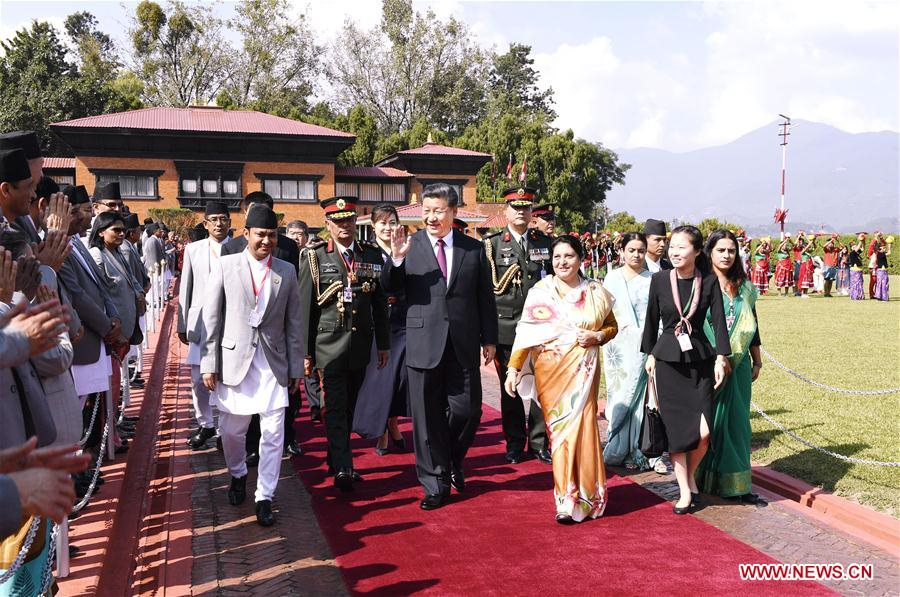
Editor's Note: Buddhi Prasad Sharma is an associate professor at Leshan Normal University and senior research fellow at the Center for Trans-Himalaya Studies. The article reflects the author's opinions and not necessarily the views of CGTN.
With Chinese President Xi Jinping's visit to Nepal October 12-13, the two countries have decided to elevate the China-Nepal Comprehensive Partnership of Cooperation to Strategic Partnership of Cooperation.
China and Nepal have many common values to enhance cooperation. As President Xi said Nepal wouldn't be a landlocked country in the future as the trans-Himalayan connectivity network ultimately will support sustainable development and stability of the entire South Asia region.
Now, the priority should be to focus on the implementation of signed agreements and acknowledged policies. In the two days of Xi's visit, Nepal and China signed 18 memorandums of understanding (MoUs) and two letters of exchange.
Both countries recognized that their bilateral relationship is characterized by equality, harmonious coexistence, everlasting friendship and comprehensive cooperation. Besides, they also reaffirmed their commitment to broaden the level of cooperation under the spirit of the Belt and Road Initiative (BRI).
Moreover, China and Nepal have agreed to enhance connectivity through ports, railways, roads, aviation and communications within the broad framework of the BRI and the Trans-Himalayan Multi-Dimensional Connectivity Network.
The two sides, while recalling the MoU between the two countries on June 21, 2018, on cooperation in railways, agreed to launch the feasibility study as delineated in the MoU signed on October 13, 2019, which will lay a significant foundation for the construction of the cross-border railway and also agreed to extend cooperation on the Kathmandu-Pokhara-Lumbini railway project.
They also agreed to foster cooperation and exchanges in culture, education, media, tourism, think tank, traditional medicine and youth at various levels.
Nepal has always stuck to the one-China policy. With political changes in China in 1949 and in Nepal in 1950 behind them, the two countries established formal diplomatic relations in 1955.
Since then, based on mutual trust and understanding, both countries have been enhancing cooperation and friendship in an excellent manner. This friendship now constructively culminates with their strategic partnership.
As President Xi said, it is also Nepali aspiration to become land-linked and open an easy access to the rest of the world. The main aim is to reduce dependence on transit through India and achieve the goal of vibrant economic development and prosperity.
As Nepal is situated at a geo-strategically and geopolitically important location, major powers of the world want to enhance their presence there. Nepali leadership, as before, should always see the need to maintain balanced relations with them. Nepali soil should not be given to hatch or play games against any neighboring countries.

Nepali President Bidya Devi Bhandari hosts a grand farewell ceremony for Chinese President Xi Jinping at the airport in Kathmandu, Nepal, October 13, 2019. /Xinhua Photo
Nepali President Bidya Devi Bhandari hosts a grand farewell ceremony for Chinese President Xi Jinping at the airport in Kathmandu, Nepal, October 13, 2019. /Xinhua Photo
The country has been enjoying strong political stability, high economic growth and political willingness to harness development. Institutionally, Nepal is working hard to realize its goal of "Prosperous Nepal, Happy Nepali."
China has showed its willingness to share its development experiences, practices and inclusive economic governance approaches. Surely, Nepal and China have been practicing different political, economic and social models, but through sharing and exchanging experiences will find greater common understanding and consensus to extend the partnership and friendship.
President Xi's great interest in expanding the Trans-Himalayan Multi-Dimensional Connectivity Network has raised hopes in Nepal. Through multiple connectivity, both countries can establish a vibrant economic corridor and build a community of shared future.
If plans and signed agreements are implemented properly, geopolitical factors will never be obstacles for China-Nepal cooperation and Nepal could also be a dynamic bridge between China and India, and China and South Asia.
As President Xi has said on many occasions at international forums, major challenges the present world faces could only be resolved through comprehensive dialogue, strategic communication and exchanges. Zero-sum game or any type of geopolitical or geo-strategic games will only destroy harmony, peace and stability of the entire world.
History shows that Nepal and China are trusted friends and always supportive of each other in all circumstances.
In conclusion, President Xi's historical Nepal visit is a new milestone in China-Nepal bilateral relations. As an active party of the BRI, Nepal is working seriously to garner cooperation and connectivity. Nepali people also feel that by building a close partnership with China and the rest of the world through the BRI, they could resolve many structural problems, prosper and contribute to the world community.
Xi's visit really opens a new chapter of bilateral productive development and the qualitative change of the entire region.
(If you want to contribute and have specific expertise, please contact us at opinions@cgtn.com.)